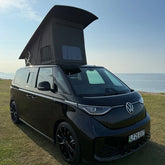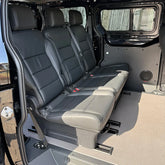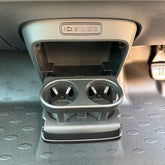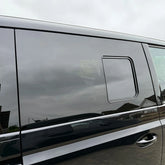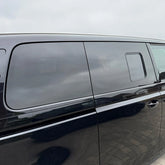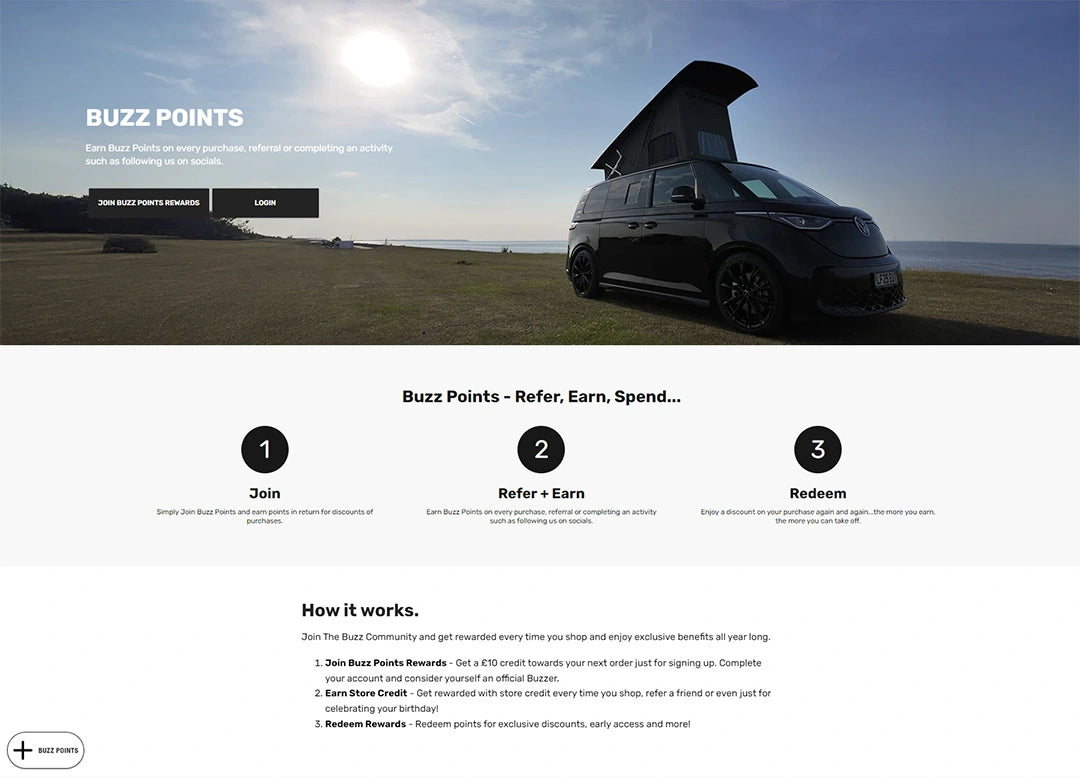Your VW Van Conversion Guide for the ID. Buzz Cargo
A VW van conversion is all about turning a standard van into a camper that’s uniquely yours. The arrival of the all-electric VW ID. Buzz Cargo signals an exciting new chapter for this lifestyle, blending the soul of a classic VW camper with the clean-running tech of tomorrow. It's a fresh canvas for building your dream adventure wagon.
Your Electric Camper Dream Starts Here
Welcome to the next generation of van life. For decades, the idea of a VW van conversion has been the ultimate symbol of freedom for adventurers—a ticket to a life less ordinary. That dream has always been fuelled by petrol or diesel. Until now. With the all-electric VW ID. Buzz Cargo, the rules have been rewritten. This guide is your starting point for navigating this new road.
Picture it: the timeless charm of a classic VW bus, but with the silent, powerful, and sustainable ride of an electric vehicle. This isn’t just a nice idea; it’s the new reality for van builders and travellers. The ID. Buzz Cargo isn't just another van; it's a clear statement about the future of road trips and exploring our world responsibly.
The ID. Buzz Cargo: A New Canvas for Conversion
Converting an ID. Buzz Cargo isn't quite like working with a traditional van. Its design brings a mix of brilliant opportunities and new challenges that you’ll need to think about right from the start. Getting your head around these differences is the key to a successful build.
Three things, in particular, need to be on your radar:
-
Weight Management: The ID. Buzz Cargo carries a heavy battery pack. That means every single thing you add, from the insulation to the kitchen cupboards, has to be as lightweight as possible. It’s a constant balancing act to protect your payload and, crucially, your driving range.
-
Electrical Independence: The power for your lights, fridge, and sockets needs its own dedicated system, completely separate from the van's main battery. This calls for a smart leisure electrical setup, usually topped up with solar panels to keep you self-sufficient.
-
Innovative Layouts: The van’s interior shape and completely flat floor (thanks to that underfloor battery) throw the door wide open for clever and practical layouts that were tricky to pull off in older, engine-in-the-way models.
Think of this guide as your trusted co-pilot, here to take you from that first flicker of an idea all the way through the real-world steps of building a smart, road-ready electric camper from your ID. Buzz Cargo.
Taking on a VW van conversion with the ID. Buzz Cargo is more than just a DIY project; it's a chance to be part of a new wave of van life. You're building a space that’s not only a pleasure to travel in but is also gentler on the beautiful places you're setting out to see. It’s a journey that will test your skills and creativity, but the pay-off is a one-of-a-kind camper that nails the blend of style, function, and sustainability for all the adventures waiting for you. Let's get started.
How to Plan and Budget Your ID. Buzz Cargo Conversion
Every great VW van conversion starts long before you pick up a single tool. It begins with a solid plan for your ID. Buzz Cargo. I’ve seen it time and time again: taking a moment to think strategically before you start cutting plywood or ordering parts will save you a world of headaches, time, and, of course, money. Honestly, this planning phase is probably the most crucial part of the entire build.
First things first, you need to get real about your travel style. Are you a weekend warrior, needing a simple, comfy base for short getaways in your ID. Buzz? Or are you dreaming of long-haul tours that call for serious storage and all the creature comforts? Answering this question will guide every single choice you make, from your furniture layout to how complex your electrical system needs to be.
Your answer has a direct knock-on effect. A weekend ID. Buzz camper can probably get away with a portable power station and a good-quality cool box. But if you’re planning on living in it for weeks at a time, you’ll need a robust leisure battery system, a proper 12V fridge, and maybe even a small water system for a sink.
Defining Your ID. Buzz Cargo Conversion Budget
Once you’ve got that vision clear in your head, it’s time to talk numbers. A realistic budget isn’t just a good idea; it’s essential. The ID. Buzz Cargo is a unique beast, being an electric vehicle with a hefty battery pack of its own. This means every single component you add has to be as lightweight as possible to protect your payload and driving range. This focus on lightweight materials will influence your costs, but it’s a non-negotiable part of getting it right.
This kind of detailed blueprint is exactly what I'm talking about. When you map out your ID. Buzz Cargo's interior before you start, you can allocate your budget to each specific area, knowing exactly what you need and where.
A well-planned budget for an ID. Buzz Cargo needs to be broken down into key categories. This helps you keep track of spending and see where you might be able to find savings.
Think of your budget not just as a list of costs, but as your build's roadmap. It guides your purchasing decisions and forces you to prioritise what you really need for the adventures you have planned in your ID. Buzz.
To give you a clearer picture, here’s a rough breakdown of what a mid-range ID. Buzz Cargo conversion might cost.
ID. Buzz Cargo Conversion Budget Breakdown (Estimates)
|
Component |
Estimated Cost (Low End) |
Estimated Cost (High End) |
Key Considerations |
|---|---|---|---|
|
Insulation & Sound Deadening |
£300 |
£700 |
Absolutely crucial for comfort in the ID. Buzz. Go for lightweight, high-performance materials. |
|
Leisure Electrical System |
£1,500 |
£4,000+ |
A major investment. Includes solar, leisure battery (lightweight LiFePO4 is best), inverter, and wiring. |
|
Custom Cabinetry & Bed |
£1,000 |
£3,500 |
The heart of your living space. Lightweight plywood and clever construction are your friends here. |
|
Plumbing & Appliances |
£500 |
£1,500 |
Even a simple setup adds up. Factor in a 12V fridge, water containers, a pump, and a sink. |
|
Interior Finishes |
£400 |
£1,200 |
This covers your flooring, wall panels, ceiling cladding, and any upholstery for the ID. Buzz. |
Keep in mind these are just estimates. The final figure really depends on your choices—you can always find ways to be thrifty or to splash out on premium gear for your ID. Buzz.
Your Conversion as a Smart Investment
It’s easy to see a VW van conversion as just another expense, but that’s a very narrow way of looking at it. A high-quality, well-executed ID. Buzz Cargo build is an investment that can seriously increase the value of your vehicle. While you're building it for your own adventures, it’s nice to know it can be a financially sound decision, too.
The market for converted electric campervans is incredibly strong. A professional-standard conversion can add thousands of pounds to a van's resale price, often far more than the cost of the parts. This makes spending a bit more on quality components and craftsmanship for your ID. Buzz a much easier pill to swallow.
From a practical view, this means even your choice of seating can be an upgrade. For instance, fitting a tested, high-quality VW ID Buzz Cargo kombi seat conversion not only improves safety and comfort but also adds to the van's professional finish and versatility. At the end of the day, a documented, safe, and functional build is always going to be more attractive to a future buyer than a slap-dash amateur job.
Designing a Smart and Functional Camper Layout for the ID. Buzz Cargo
Figuring out the layout for your VW ID. Buzz Cargo is a bit like solving a fascinating puzzle. You're constantly juggling comfort and practicality with the hard limits of space and, most critically, weight. When you get it right, your van feels spacious, organised, and just a fantastic place to be. But if you get it wrong, you’ll end up feeling cramped and constantly fighting for every inch.
The real aim is to design an interior that flows naturally with how you live. Before you draw a single line, think about your daily routine on the road in the ID. Buzz. Where will you cook, eat, sleep, and just kick back and relax? Visualising this flow is the first real step toward a layout that genuinely works for you.
What's great about the ID. Buzz Cargo is its completely flat floor, a real bonus compared to traditional diesel vans that have a bulky transmission tunnel in the way. This opens up a whole new world of layout possibilities. The flip side, of course, is that you have to be mindful of the heavy drive battery sitting right under your feet.
Working with the ID Buzz Cargo's Unique Constraints
The single most important factor to nail in your ID. Buzz Cargo layout is weight distribution. It’s not just about how the van handles; an unbalanced load can cause uneven tyre wear and seriously compromise your safety. Your design must spread the weight of all your heavy gear as evenly as possible, both side-to-side and front-to-back.
To get this right, keep these principles in mind:
-
Centre Your Heavy Items: Things like water tanks and leisure batteries need to be placed low down and as close to the van's centre as possible. This is key to maintaining a low, stable centre of gravity.
-
Balance the Load: If you've got a hefty kitchen unit running down one side, you need to balance it out with storage or other features on the opposite side. Think of it like a set of scales.
-
Avoid a Rear-Heavy Build: It’s a classic mistake to load too much weight behind the rear axle. This can make the front end feel light, which is bad news for both steering and braking.
A smart layout isn't just about cramming everything in. It's about arranging everything in a way that respects the vehicle's engineering. The best VW van conversion layouts feel like they were always meant to be there, working in perfect harmony with the ID. Buzz Cargo itself.
Popular Layout Concepts for the ID. Buzz Cargo
While your imagination is really the only limit, most ID. Buzz layouts tend to follow a few tried-and-tested concepts. These serve as a great starting point that you can tweak to fit your own needs, whether you’re a solo traveller or heading out with the family. It always helps to see how others have tackled the same challenge, and you can explore galleries of professional builds to see just what’s possible with an ID. Buzz Cargo.
Here are a few of the most popular approaches:
|
Layout Style |
Best For |
Key Features |
|---|---|---|
|
Side Kitchen |
All-round use, solo or couples |
A classic, versatile design. A long kitchen unit runs down one side of the van, opposite a rock-and-roll bed that doubles as your daytime seating. |
|
Rear Galley |
Weekend adventures |
The kitchen unit is at the very back of the van, designed to be used with the tailgate open. This frees up the main living space for a bigger bed or more seating. |
|
L-Shaped Lounge |
Socialising and comfort |
An L-shaped sofa at the rear creates a really spacious lounge area, which then converts into a large double bed. This layout feels incredibly open and is perfect for relaxing. |
Maximising Every Inch with Smart Design
In a compact space like the ID. Buzz Cargo, everything you build should ideally do more than one job. This is the secret to creating a van that’s packed with features but doesn't feel cluttered.
Think in terms of convertible furniture. A simple bench seat can provide storage and hide a water tank inside. A tabletop can be designed to swing out of the way or drop down to form part of the bed base. This multi-functional mindset is absolutely essential for an ID. Buzz.
This philosophy extends to your materials, too. Your cabinets have to be tough, but they also have to be incredibly light. Forget about standard MDF or chipboard; it's simply too heavy for an ID. Buzz conversion. Instead, professional converters use materials like lightweight poplar plywood or specialist honeycomb composite boards. These give you fantastic strength without eating into your precious payload, helping you create a clutter-free, functional, and lightweight build that’s ready for adventure.
Building the Foundation: Insulation, Soundproofing, and Flooring for the ID. Buzz Cargo
Right, this is where your empty ID. Buzz Cargo starts its real journey from a bare metal box to a proper home on wheels. Before we get carried away with layouts and kitchens, we need to lay the groundwork. This means tackling three absolutely crucial stages: sound deadening, insulation, and installing the floor. Honestly, getting these fundamentals right sets the standard for the entire build.
Quieting the Ride with Sound Deadening
One of the best things about the ID. Buzz Cargo is how quiet the electric motor is. The flip side is that you notice every other little noise, especially the drumming sound that comes from the road vibrating through the big metal panels. This is where sound deadening comes in.
It’s your first line of defence. The process involves sticking self-adhesive mats, usually made from butyl rubber and aluminium, directly onto the metal panels of the ID. Buzz. Think of it like putting your hand on a ringing bell – it just stops the vibration in its tracks. You don’t need to plaster the whole van. Aiming for around 30-40% coverage on the biggest, flattest areas like the walls, wheel arches, and ceiling is plenty to make a huge difference. You'll be surprised at how much more peaceful your living space feels.
Choosing the Right Insulation for your ID. Buzz
If there’s one step you don't want to skimp on, it’s insulation. This is what keeps your ID. Buzz toasty in winter and cool in summer, but it also does the vital job of managing condensation. For an electric van where every bit of energy efficiency counts, making a smart choice here is key.
You're essentially juggling three things:
-
Thermal Performance (R-Value): This is just a measure of how well a material stops heat from passing through it. Higher R-value means better insulation. Simple.
-
Moisture Resistance: Vans get damp inside; it's a fact of life. You need insulation that won’t soak up water like a sponge, which can lead to mould and rust.
-
Weight and Sustainability: Every kilo matters in the ID. Buzz Cargo. Lightweight materials are a must, and thankfully, there are some great eco-friendly options available now.
The right insulation isn't just about staying warm; it's about creating a healthy, dry, and efficient living environment that protects both you and your ID. Buzz from the elements.
There are a few go-to materials, each with its own quirks. We’ve brought together a selection of high-performance options specifically for ID. Buzz projects, which you can see if you explore our sound and insulation products.
Common Insulation Materials for Your ID. Buzz Cargo
|
Material |
Key Benefits |
Considerations |
|---|---|---|
|
Sheep's Wool |
Great for warmth and sound, it's sustainable and even helps manage moisture naturally. |
Can be pricier and you need to pack it in properly to stop it from sagging over time. |
|
Recycled Plastic |
Made from recycled bottles, it’s light, eco-friendly, and completely water-resistant. |
The R-value is decent but not the highest, so you might need a thicker layer for deep winter trips. |
|
Closed-Cell Foam Board |
Packs a high R-value for its thickness and acts as its own vapour barrier. It’s also solid and adds a bit of structure. |
It’s rigid, which makes it tricky to fit into all the nooks, crannies, and curves of the ID. Buzz. |
Installing the Subfloor and Flooring
Once the ID. Buzz Cargo is fully insulated, the last piece of the foundation puzzle is the floor. This gives you a flat, solid, and tough surface to build everything else on top of. It’s a multi-layer job: a subfloor frame, more insulation, and then your final finished flooring.
-
Lay Wooden Batons: First, you’ll glue thin wooden batons to the metal floor of the van. These create a frame and a small air gap.
-
Add Floor Insulation: Cut rigid foam board insulation to fit perfectly between the batons. This stops cold from creeping up from underneath.
-
Install the Subfloor: A sheet of 9-12mm lightweight plywood gets fixed on top of the batons. This is what gives you that solid floor feel.
-
Choose Your Finish: Finally, you can lay your actual flooring. A hard-wearing, lightweight vinyl is a fantastic choice because it’s tough, waterproof, and dead easy to clean.
Don't rush this stage. Taking the time to make neat cuts and fit everything together securely will save you from a world of annoying squeaks and rattles later on. It’s what gives the finished build that professional, solid feel under your feet.
Installing the Off-Grid Electrical System for Your ID. Buzz Cargo
When you're converting an electric van, figuring out the power is a whole different ball game. There's one golden rule for any VW van conversion on an ID. Buzz Cargo, and it's a big one: you do not touch the main drive battery. Period. Everything in your camper—the fridge, the lights, the water pump—has to run on its own, completely separate leisure electrical system.
Think of it this way: your van has two hearts. The first is the powerful one that gets you up the motorway and down country lanes. The second is the one that keeps your home-on-wheels alive when you’ve parked up for the night. Keeping them separate is crucial for protecting your warranty and, more importantly, making sure you can always drive away. It's one of the most technical parts of the build, but getting it right is incredibly satisfying.
Calculating Your Power Budget
Before you even think about buying a battery or a solar panel for your ID. Buzz, you need to become an energy detective. You have to figure out exactly how much power your setup will realistically use each day. This is called a power audit, and it’s the bedrock of a system that won't let you down. Grab a notepad and list every single 12V appliance you plan to install, along with how many hours a day you expect it to run.
Common culprits for power consumption in an ID. Buzz camper include:
-
12V Compressor Fridge: This will almost certainly be your biggest power user. Look at the manufacturer’s specs for its average 24-hour consumption.
-
LED Lighting: They're efficient, but those hours quickly add up.
-
Water Pump: It only runs for short bursts, but every little bit counts.
-
Device Charging: Laptops, phones, and cameras all need their juice.
-
Diesel Heater (if fitted): The fan and fuel pump both run on your 12V system.
Once you have a grand total, measured in Amp-hours (Ah), you can start shopping for a battery with confidence. A good rule of thumb is to have enough battery capacity to last at least two full days without seeing a single ray of sunshine.
Your leisure battery is the core of your off-grid freedom. Sizing it correctly based on a detailed power audit is the difference between a system that works flawlessly and one that constantly leaves you in the dark.
Choosing Your Leisure Battery and Solar Setup
For an ID. Buzz Cargo, weight is everything, which makes the battery choice pretty simple. A Lithium Iron Phosphate (LiFePO4) battery is the undisputed champion here. Yes, they cost more upfront, but they are dramatically lighter than old-school lead-acid batteries, last far longer, and can be almost fully drained without being damaged. For an EV conversion, they are the perfect fit.
To keep that battery happy, solar power is your best mate. You’ve got two main options for the roof of your ID. Buzz Cargo:
-
Rigid Panels: These are the workhorses. They're typically more efficient and durable, mounted on a roof rack. This leaves a vital air gap underneath, which helps keep them cool and performing at their best.
-
Flexible Panels: The stealth option. These can be bonded directly to the roof for a sleek, aerodynamic look. The trade-off is that they're usually a bit less efficient and can lose performance over time due to heat.
No matter which panels you go for, they absolutely must be wired into a Maximum Power Point Tracking (MPPT) solar charge controller. An MPPT is worlds away from a basic PWM controller. It intelligently squeezes every last drop of energy from your panels, delivering up to 30% more charging power to your battery—a game-changer in the often-overcast British weather.
Prioritising Electrical Safety
Working with a 12V system might feel safer than fiddling with your home’s wiring, but don't be fooled. A badly wired campervan is a serious fire risk, and safety has to be your number one priority. Every single positive wire coming from your battery needs to be protected by a fuse or circuit breaker that's correctly rated for the appliance it’s running. This isn’t optional; it’s your most critical line of defence.
Just as important is using the right thickness of wire (or gauge). A wire that's too thin for the amount of current passing through it will get hot, melt its insulation, and can easily start a fire. Always consult a wire gauge chart to pick the right cable for each circuit's length and amperage. Finally, make sure the whole system is properly earthed to the van's chassis to prevent short circuits and protect both you and your gear.
This focus on safe, practical builds is part of a long tradition in the UK. Volkswagen Transporters have been the go-to base for camper conversions for decades, creating a huge community of enthusiasts who value quality work. That legacy is now being passed on to modern vans like the ID. Buzz Cargo. You can see just how deep these roots go by looking at official registration data. Discover more insights about the prevalence of Volkswagen campervans in the UK.
Right, you've built your dream campervan from an ID. Buzz Cargo. The hard work is done, the vision is real, but there's one last, vital hurdle to clear: making it all official. Getting your converted ID. Buzz legally recognised and insured for UK roads isn't just about ticking boxes; it's the final step that gives you true peace of mind for every adventure ahead.
The main job here is to update your vehicle's logbook (the V5C) with the Driver and Vehicle Licensing Agency (DVLA). You need to change its official classification from a commercial 'panel van' (N1) to a 'motor caravan'. This is a critical distinction that affects everything from your insurance policy to MOTs and even the speed limits you have to follow.
Volkswagen's long-standing popularity in the UK commercial scene means there’s a well-trodden path for converters. In 2020 alone, VW registered 32,349 light commercial vehicles, a testament to their reliability as a base for projects like these. This history has helped shape the clear guidelines we can now follow for vans like the ID. Buzz Cargo. Read more about VW's history in the UK van market.
What the DVLA Needs to See
To get that all-important 'motor caravan' status, the DVLA has a checklist. They want to see clear, permanent evidence that your ID. Buzz Cargo has been properly converted for living in. Think of it as the official test that separates a van with a mattress in the back from a genuine campervan.
Your conversion needs to have most of these features clearly visible inside:
-
A bed with a minimum length of 6 feet, which can be made from seats
-
A permanent water tank with a tap and sink
-
A fixed seating and dining area, complete with a table
-
A cooking facility that is secured within the van
-
At least one wardrobe or cupboard for storage
Getting the DVLA's green light is the ultimate seal of approval. It’s the moment your ID. Buzz project officially transforms from a work van into a certified home on wheels.
Build with Safety at the Forefront
Beyond the paperwork, safety has to be woven into every part of your build, especially with an electric vehicle like the ID. Buzz Cargo. The single biggest challenge? Payload management. The van is already carrying a lot of weight from its large drive battery, so every single kilogram you add—from the bed frame to the kitchen unit—counts.
Exceeding the van’s Gross Vehicle Weight (GVW) isn't just illegal; it's incredibly dangerous, seriously compromising how the van brakes and handles. You also have to be mindful not to block any of the vehicle's built-in safety features. That means ensuring airbags can deploy, sensors aren't covered, and the chassis's structural strength isn't weakened.
Ultimately, a safe, compliant, and correctly insured VW van conversion is more than just a legal requirement. It's the very foundation of every worry-free trip you'll ever take in your ID. Buzz Cargo.
Got Questions About Your ID. Buzz Cargo Conversion? We've Got Answers.
Stepping into the world of van conversions is exciting, but it's totally normal to have a long list of questions, especially when you're working with a game-changing electric vehicle like the ID. Buzz Cargo. Let's tackle some of the most common queries we hear from folks just starting their journey.
Core Differences and Warranty Concerns
How is converting an electric ID. Buzz Cargo different from a diesel van?
The two biggest hurdles are weight and power. First off, the ID. Buzz Cargo is already a hefty vehicle thanks to its large battery pack. This means every single thing you add—from the bed frame to the kitchen cabinets—has to be as lightweight as possible. It's a constant balancing act to protect your payload capacity and, crucially, your driving range.
Secondly, you've got to think about your electrical system differently. You'll be building a completely separate leisure power system. This setup, usually powered by robust solar panels, will run all your creature comforts like lights, a fridge, and chargers, ensuring you never have to tap into the van's main drive battery.
Will doing a DIY conversion void my VW ID. Buzz Cargo warranty?
It's a definite "maybe," so you need to tread carefully. Any modification you make that directly leads to a fault won't be covered. For example, if you accidentally nick a wiring loom while putting up a wall panel and it causes an electrical issue, VW isn't going to foot that repair bill.
That said, a problem with the motor or the main battery that's clearly unrelated to your conversion work should still fall under the standard warranty. The key is to use non-invasive installation methods wherever you can and have a chat with your dealer about their specific policies before you start.
The single most important part of any VW van conversion is detailed planning. Before you buy a single sheet of plywood for your ID. Buzz, you need a finalised layout, a complete electrical plan, and a realistic budget.
Taking the time to create a scaled drawing, list out every component, and calculate your total weight is the best thing you can do. It'll save you from the classic pitfalls of going over budget, dragging out your timeline, and ending up with a layout you don't actually like. Think of it as the blueprint for a successful and enjoyable build.
Ready to start your own electric campervan adventure? Buzz Conversions offers everything you need for your ID. Buzz Cargo, from bespoke interiors and pop-top roofs to professional advice and premium components. You can turn your vision into a zero-emissions reality and get ready to explore.

